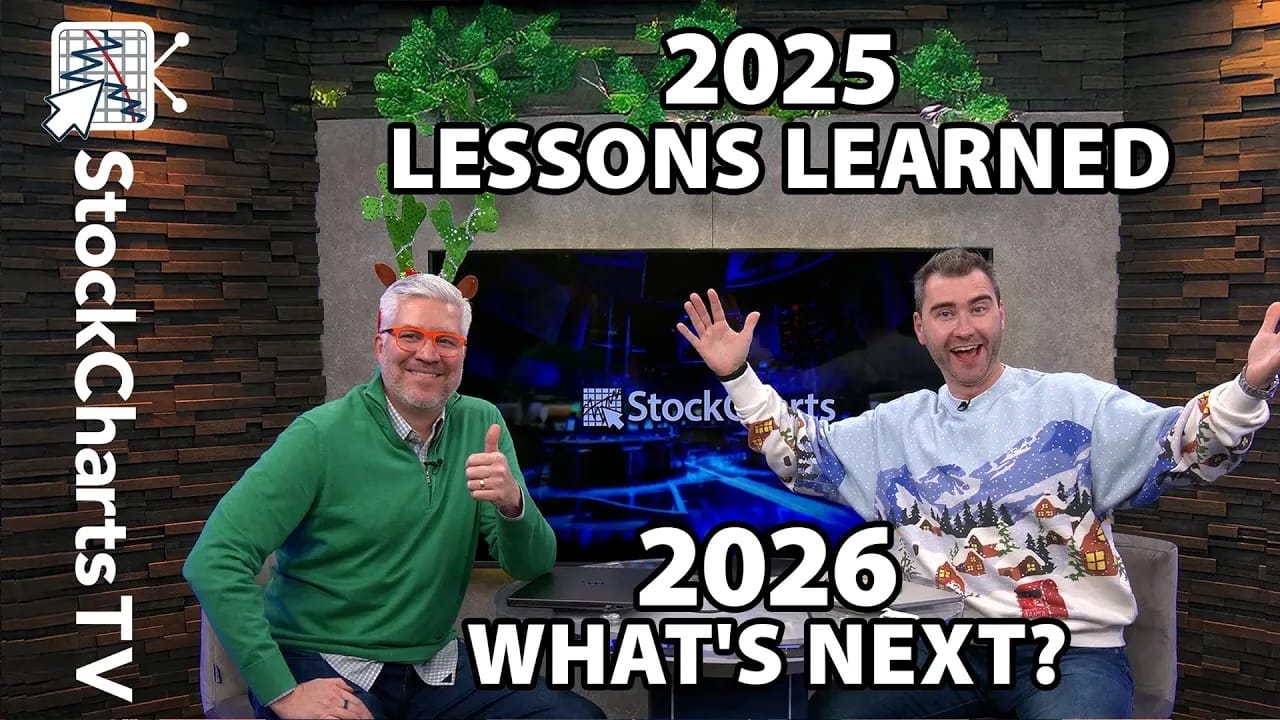SPY MAKES IT 12 STRAIGHT - PARTY LIKE IT'S 1995 - OIL HITS RESISTANCE - WEAKNESS IN OIL WEIGHS ON XLE - OIH REMAINS IN UP SWING
SPY MAKES IS 12 STRAIGHT... Link for todays video. The S&P 500 ETF (SPY) eked out another gain on Monday to make it twelve straight days with a closing gain. Chart 1 shows SPY trading above its January high the last three days. The blue dotted lines define the last three swings. This swing is up as long as the February trendline holds. A hanging man candlestick formed on Monday. These have small bodies (black or white) and relatively long lower shadows (intraday low). One candlestick can provide a good idea of what happened intraday. Todays hanging man shows that the ETF opened slightly lower, declined below 115 and rallied back above its open by the close. There was intraday selling pressure, but little change from open to close. According to candlestick theory, these are bearish reversal patterns that require confirmation with further weakness. A black candlestick and close below todays low would confirm. Keep in mind that candlestick patterns are short-term and only valid for 1-2 weeks (if confirmed).

Chart 1
PARTY LIKE ITS 1995... As far as I can tell, September 1995 was the last time the S&P 500 ETF advanced 12 days in a row. The 12-day advance in September 1995 advance was 4.51%, while the 12-day advance in March 2010 is currently 4.36% (and possibly still counting...). Chart 2 shows SPY in 1995. After the 12-day advance, the ETF formed a trading range that extended from mid September to early November. The bears were pointing to a broadening formation that never panned out. Instead, the ETF held support around 50.5 with a piercing pattern and surged above 54 in early December. The bears then pointed out the lower high and support break for a trend reversal in January 1996. Wrong again as SPY sprung a bear trap with a failed support break and zoomed to new highs in February. Hmm....this sounds familiar.

Chart 2
Taking a step back in time, we can see that 1995 was one heck of a year - and so was 1996. Chart 3 shows weekly candlesticks from late 1994 until early 1997. The blue arrow shows the end of the 12-day rally in September 1995, followed by six weeks of sideways action. SPY then continued higher with a move above 52.5 and then above 57.5. It was not until the move above 57.5 that SPY embarked on a 6-7 month trading range. Notice that this trading range ended with a high volume decline in July 1996. Thats right. Downside volume surged, but SPY formed a weekly hammer and continued higher on lower volume. This rally did not need higher volume. In fact, volume did not pick back up until November 1996, which marked the second half of the move. There was also another high volume decline at the end of 1996, but this did not mark the top and SPY continued above 70 in February 1997. Incidentally, the red arrow marks a peak that preceded a 10% correction.

Chart 3
OIL HITS RESISTANCE... News that OPEC increased drilling at the fastest rate in 2 1/2 years weighed on oil prices Monday. In addition, there were concerns that monetary tightening in China could weigh on demand. John Murphy noted on Saturday that weakness in Chinese stocks could weigh on commodities. Chart 4 shows weekly candlesticks for the US Oil Fund ETF (USO). There is a lot of resistance around 40 that extends back to June 2009. USO has been flat since summer. A move above the January high is needed to revive the bulls and target higher prices. Chart 5 shows daily bars over the last eight months. After breaking the July trendline and forging a lower low in February, USO surged back above 40 in March. While this surge looks impressive, it is possible that lower highs are taking shape (red arrows). At this point, I think oil is likely to cue off the US and Chinese stock markets. As long as both remain buoyant, oil should be able to hold its gains and downside should be limited. A reversal and decline by one or both could weigh on oil - and other commodities. The indicator window in Chart 5 shows USO and SPY. Notice how USO surged along with SPY from early February to mid March.

Chart 4

Chart 5
WEAKNESS IN OIL WEIGHS ON ENERGY STOCKS... Chart 6 shows the Energy SPDR (XLE) falling over 1% on Monday. It was the only sector to lose more than 1%. XLE has been range bound since mid October. The ETF established resistance in the 60-61 area and support in the 54-55 area. With a close around 58, XLE is currently trading close to the middle of its six month range. The trend within the range remains up as XLE advances within a rising wedge. Wedge support is set just below 57 and a move below the March low would reverse the rising wedge. The bottom indicator shows USO and XLE tracking pretty close over the last eight months.

Chart 6
Chart 7 shows the Oil Service HOLDRs (OIH) with a pattern similar to XLE. Notice, however, that OIH is more volatile than XLE. The range for XLE extends from 53 to 61 (~13%), but the range for OIH extends from 110 to 132 (20%). OIH is like XLE on steroids. OIH is also range bound over the last six months and the swing within the range remains up. A trendline break would be the first sign of a reversal.

Chart 7











